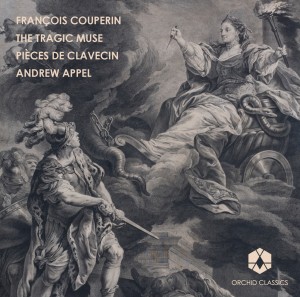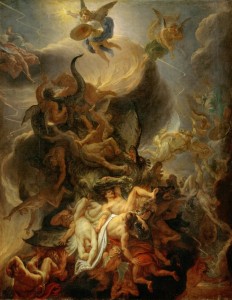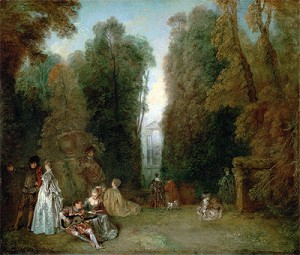
Open Book One of Couperin’s Pieces de Claveçin and look at the first two pages of music. In contrast to the published volumes of d’Anglebert, Rameau, Le Roux and Marchand, Couperin opens not with a prélude, or improvisatory awakening of the instrument but rather with an Allemande Grave. Four of the five suites of Book 1 (and several in the following three volumes) have monumental works that serve as introductions to each collection of pieces, collections he calls ordres. Performed with the required repeats, these allemandes are impressive in stature and reminiscent of canvases of Charles Le Brun, the great history painter to Louis XIV. Each allemande establishes a compelling atmosphere but then explores textures, ranges, rhetorical figures and motion. With Couperin, our ears voyage through sound and time as our eyes travel over space and form in a painting by Charles Le Brun. The dark browns or greens of the land, the blue and white of the sky above and the gold and pinks of a distant sunset or the black and red horrors of battle all have comparable contrasts in the music of Couperin. These allemandes alone justify calling him Le Grand, the title bestowed on François Couperin during his lifetime.
PRESS HERE TO LISTEN TO LA RAPHAEL, A GRAND ALLEMANDE from the 8th Ordre
Harpsichordists who explore and know Couperin’s world understand that grandeur is only one pose, one affect on the palate of this composer who believed more than any in the expressive capabilities of his instrument. Couperin demands more grace and control from his player than any other French claveçinist, and rewards our efforts to interpret his works with a harvest of the instrument’s most tender, limpid, filigreed, voluptuous, vulnerable and perfumed charms. He masters the harpsichord as Chopin masters the piano.

With the publication of Book 1 in 1713, Couperin assumed his rightful position in a tradition of Parisian harpsichord composition already in full flower and influential throughout Europe. His earliest style is formed in the salon, theater and church of Louis XIV. If he were not a genius, his music might have been pompous. If he were not a genius his works might have been precious and obscure. Thanks to that genius, he takes the language of the later 17th century to its highest level. At the same time, he hints that Paris is headed towards a great change in artistic values. Indeed, just as the architect Gabriel mastered the decorative styles of Louis XV and then invented the contrasting style of Louis XVI, so too do Couperin’s Books 2, 3, and 4 for the harpsichord define the new musical rococo. His music parallels the exquisite melancholy of French painter Antoine Watteau and the virtuosity and wit of the pastel portraitist, Maurice Quentin La Tour, both younger contemporaries.
For this first in a series of records, I have chosen Couperin at his most dramatic, powerful, and often tragically brilliant. The third ordre is a finely chosen selection of pieces in C minor and major. While Couperin may have had no specific overall architecture in mind for this selection, he is successful in offering us great variety, ranging from the classical theatricality of La Tenebreuses and the tender sighing of Les Regrets to the riotous clowning of Les Matelotes Provençales. Let us remember that when he gathered the music for his first book of harpsichord works, he was amassing selections from over 20 years of composing. This is truly a retrospective collection of harpsichord pieces.
PRESS HERE TO LISTEN TO LES REGRETS, from the 3rd Ordre
Not so with the Huitieme ordre from Book 2. Couperin deftly groups contrasting pairs, two allemandes, two courantes, two gigues, a few other dances and his great Passacaille, all coming together to make a work that is best heard in its entirety, from the first dark B minor chord to the last.
Couperin has written that he preferred that which moved him to that which surprised him. As we listen to his 27 ordres we become more and more aware of how beautifully he uses one note, one unexpected ninth or melodic turn to allow the composition to transcend any suspicion of pretty banality. But the painfully dissonant hammered chords of the Passacaille, the tragedy of its penultimate couplet, reach our ears with as much nobility and sentiment as a fountain statue in the park of Versailles or a tragic monologue in a play by Racine. Passion and poise are so perfectly balanced in Couperin’s music that though the real world might, at any instant, crumble under our feet, we are, as long as his music is our reality, living in a world of Calme, Luxe et Volupté.





Andy, this is truly wonderful writing about music to accompany what I already know is an exquisite performance. Is there a book in the works?
sounds ravishing…can’t wait to hear the rest.
Thank you for this beautiful writing and playing, Andy.
Hi A,
Congratulations on both the recording and the blog!
Which harpsichord is that on Les Regrets? Sounds beautiful.
Charlie
HI Charlie
The harpsichord is a 1991 Rutkowski and Robinette copy of a Ruckers, the original having been enlarged (petit ravalement) in the later 17th century probably in Germany. The original is housed at the Met Museum in NYC and was owned by Hugh Gough. It is a four jack, three register instrument with a dogleg coupler with a range of BB/GG-d3.